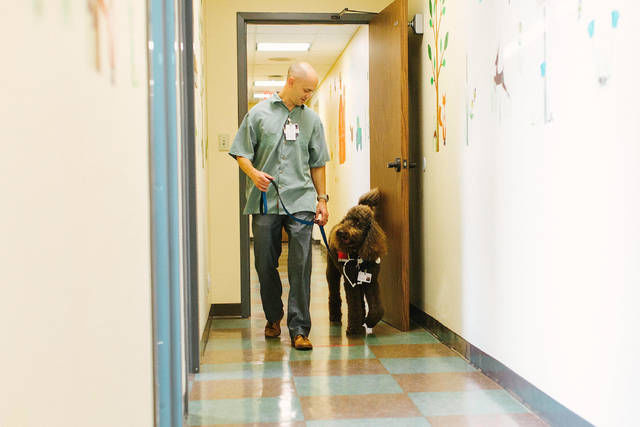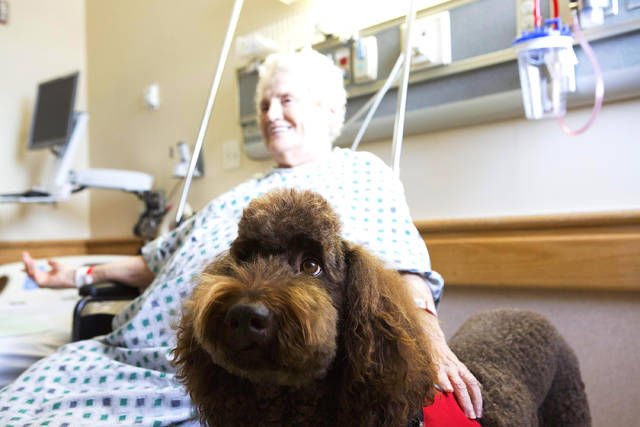LIHUE — Andy Bestwick and Rudy are a dynamic duo at Wilcox Medical Center. Bestwick, a development officer for Hawaii Pacific Health Foundations, representing Wilcox Health Foundation, works mostly behind the scenes to help patients, while Rudy, his four-legged friend,
LIHUE — Andy Bestwick and Rudy are a dynamic duo at Wilcox Medical Center.
Bestwick, a development officer for Hawaii Pacific Health Foundations, representing Wilcox Health Foundation, works mostly behind the scenes to help patients, while Rudy, his four-legged friend, is on the frontlines, helping patients recover during their stay.
“I have seen him (Rudy) boost morale of patients, families and staff in some of the most stressful and difficult situations,” Bestwick said. “If only for a brief moment in time, he gives hope and relief to humans.”
Rudy, chief canine officer at Wilcox, received his training as a volunteer therapy dog in Las Vegas. He was trained by a professional service dog trainer, then tested by the Alliance of Therapy Dogs.
“He was a perfect fit for the work I do here at Wilcox, and the timing was right to introduce a therapy dog at the medical center,” Bestwick said.
When he’s on duty, Rudy wears a service vest bearing the message “bringing smiles and joy to people.” His official role at Wilcox is to visit any and all staff, volunteers, visitors and patients.
Oncology nurse Margaret Itami, who is also patient navigator/research coordinator for Wilcox Health, said that Rudy’s presence is felt immediately once he enters the room.
“The impact that Rudy, our amazing therapy dog, has made at our facility is immeasurable,” Itami said. “The positive and happy energy when he walks by with Andy is something that patients and families remember.”
“Having him here brings a smile to our hearts,” Itami added.
A Labradoodle (a Labrador retriever/poodle cross), Rudy has been putting smiles on patients’ faces at Wilcox for a little over a year now.
“We visit patients who are interested in and well enough to see us,” Bestwick said. “Rudy’s demeanor and intelligence made for a great experience.”
It may also help that Rudy doesn’t even look like a dog, according to Bestwick.
“First off, Rudy looks like a giant teddy bear. You cannot help but smile when you see him,” he said.
However, Bestwick pointed out, Rudy’s influence doesn’t just come from a wag of his tail: There’s actually scientific proof that animal therapy works on a chemical level.
“Researchers are learning more about animal therapy every day,” he said. “What they already know is that dogs have the ability to release oxytocin, what researchers call ‘neurochemical of love,’ but Rudy and I call it a ‘shared release’ of these feel-good chemicals, as we both get a lot of love in return. We also are benefiting from the healing powers of this shared experience.”
How do patients and hospital staff react when they see Wilcox’s furriest volunteer? Bestwick said no two reactions are the same.
“Usually it’s a surprised reaction — Rudy just doesn’t look like a real dog at first sight. Once they realize he’s a very warm and gentle animal, big smiles are pretty hard to fight off,” he said. “Hugging, gratitude, inspiration to get home to their own pets, and we like to think hopefulness are some of the reactions we get.”



